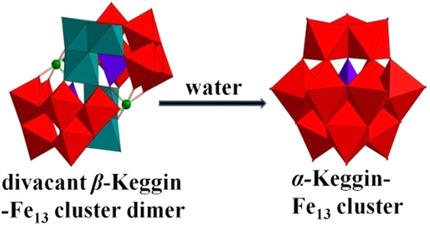当前位置:
X-MOL 学术
›
Chem. Eur. J.
›
论文详情
Our official English website, www.x-mol.net, welcomes your feedback! (Note: you will need to create a separate account there.)
Capturing Lacunary Iron-Oxo Keggin Clusters and Insight Into the Keggin-Fe13 Cluster Rotational Isomerization.
Chemistry - A European Journal ( IF 4.3 ) Pub Date : 2020-07-02 , DOI: 10.1002/chem.202002833 Xiu-Ying Zheng 1 , Man-Ting Chen 1 , Ming-Hao Du 1 , Rong-Jia Wei 1 , Xiang-Jian Kong 1 , La-Sheng Long 1 , Lan-Sun Zheng 1
Chemistry - A European Journal ( IF 4.3 ) Pub Date : 2020-07-02 , DOI: 10.1002/chem.202002833 Xiu-Ying Zheng 1 , Man-Ting Chen 1 , Ming-Hao Du 1 , Rong-Jia Wei 1 , Xiang-Jian Kong 1 , La-Sheng Long 1 , Lan-Sun Zheng 1
Affiliation

|
The formation mechanism of ferrihydrite is the key to understand its treatment of pollutants in waste water and purification of surface water and groundwater. Although emerging evidence suggests that formation of the ferrihydrite occurs through the aggregation of prenucleation clusters, rather than classical atom‐by‐atom growth, its formation mechanism remains unclear. Herein, an iron–oxo anionic cluster of [Fe22(μ4‐O)8(μ3‐OH)20(μ2‐OH)18(CH3COO)16(H2O)2]4− viewed as a dimer of bivacant β‐Keggin‐Fe13 clusters was for the first time obtained by using lanthanide ions as stabilizers. Upon dissolution in a mixed solution of isopropanol and water, the lacunary β‐Keggin‐Fe13 cluster can transform into an α‐Keggin‐Fe13 cluster, distinctly demonstrating that the Keggin‐Fe13 cluster rotational isomerization can be realized through the vacant Keggin‐Fe13 cluster.
中文翻译:

捕获Lacunary铁氧Keggin团簇并深入了解Keggin-Fe13团簇的旋转异构化。
水铁矿的形成机理是了解其处理废水中污染物以及净化地表水和地下水的关键。尽管新出现的证据表明,铁水合物的形成是通过预核簇的聚集而不是经典的逐原子生长而发生的,但其形成机理仍不清楚。在本文中,铁氧代的阴离子簇的[Fe 22(μ 4 -O)8(μ 3 -OH)20(μ 2 -OH)18(CH 3 COO)16(H 2 O)2 ] 4-视为bivacantβ-Keggin结构-Fe的二聚体13簇是用于通过使用镧系元素离子作为稳定剂获得的第一时间。当在异丙醇和水的混合溶液溶解,缺位β-Keggin结构-铁13集群可以转变成α-Keggin结构-铁13簇,清楚地证明该Keggin型-铁13簇的旋转异构化可通过空置的Keggin来实现‐Fe 13簇。
更新日期:2020-07-02
中文翻译:

捕获Lacunary铁氧Keggin团簇并深入了解Keggin-Fe13团簇的旋转异构化。
水铁矿的形成机理是了解其处理废水中污染物以及净化地表水和地下水的关键。尽管新出现的证据表明,铁水合物的形成是通过预核簇的聚集而不是经典的逐原子生长而发生的,但其形成机理仍不清楚。在本文中,铁氧代的阴离子簇的[Fe 22(μ 4 -O)8(μ 3 -OH)20(μ 2 -OH)18(CH 3 COO)16(H 2 O)2 ] 4-视为bivacantβ-Keggin结构-Fe的二聚体13簇是用于通过使用镧系元素离子作为稳定剂获得的第一时间。当在异丙醇和水的混合溶液溶解,缺位β-Keggin结构-铁13集群可以转变成α-Keggin结构-铁13簇,清楚地证明该Keggin型-铁13簇的旋转异构化可通过空置的Keggin来实现‐Fe 13簇。



























 京公网安备 11010802027423号
京公网安备 11010802027423号